Related Research Articles
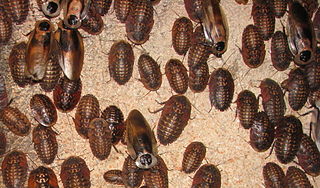
Giant cockroaches, or blaberids, are the second-largest cockroach family by number of species. Mostly distributed in warmer climates worldwide, this family is based on the American genus Blaberus, but much of the diversity is also found in Africa and Asia.

Cockroaches are insects belonging to the order Blattodea (Blattaria). About 30 cockroach species out of 4,600 are associated with human habitats. Some species are well-known as pests.
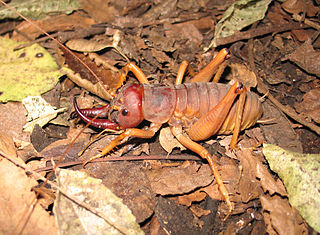
Motuweta is a genus consisting of two species of tusked wētā in the family Anostostomatidae, endemic to New Zealand. The Northland tusked wētā, Anisoura nicobarica, may belong in this group, in which case the genus Motuweta would become a junior synonym of Anisoura.
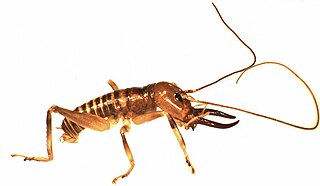
The Northland tusked wētā, Anisoura nicobarica, is a rare monotypic wētā of the family Anostostomatidae, endemic to the northern half of Northland in New Zealand, and originally described in 1932. The type specimen was wrongly labelled as coming from the Nicobar Islands, so the species was named Anisoura nicobarica. It was erroneously described again in 1950 by a different author, who placed it in the ground wētā genus Hemiandrus.

Medauroidea extradentata, commonly known as the Vietnamese or Annam walking stick, is a species of the family Phasmatidae. They originate in Vietnam and are found in tropical forests there. They eat a variety of foliage, though in captivity they commonly eat blackberry bramble, hawthorn, oak, red maple, and rose.

Protophasma is an extinct genus of Protorthopteran insect from the Carboniferous of Europe and North America.

Dictyophorus spumans, the koppie foam grasshopper or rooibaadjie, is a species of grasshopper in the family Pyrgomorphidae indigenous to southern Africa. The name "foaming grasshopper" derives from the insect's ability to produce a toxic foam from its thoracic glands. Its genus Dictyophorus is closely related to Phymateus.

Enchophora sanguinea is a species of lantern bug, a type of hemipteran, found in Central and South America. It was first described by William Lucas Distant in 1887. They are 25 millimetres (1.0 in) long. Their colour varies, but is normally red to green; they have a scimitar-shaped process on their heads. They feed on the sap of trees, most commonly Simarouba amara, and they excrete honeydew out of their anuses.
Panoploscelis is a genus of very large insects belonging to the true katydid tribe Eucocconotini, which is a subfamily of the Tettigoniidae. Like the other members of the suborder Ensifera, Panoploscelis are part of the insect order Orthoptera, which also contains crickets, grasshoppers and locusts. Members of this genus are among the largest katydids of the Neotropics.

Eumastacoidea is a superfamily within the order Orthoptera, suborder Caelifera. The family has a mainly tropical distribution and have sometimes been called "monkey grasshoppers".
Simandoa conserfariam, also known as the Simandoa cave roach, is a species of cockroach that is considered extinct in the wild. However, it is kept as a pet by insect hobbyists and is therefore not considered completely extinct. Its only known habitat was one cave in the Simandou region of Guinea, where it lived in guano. Individuals can be recognized by their unique coloring across their head and body regions.

Zonocerus is a genus of grasshoppers (Caelifera) in the family Pyrgomorphidae and the tribe Phymateini. The two species are found in Africa, with Z. elegans found in central, eastern and southern regions, including Madagascar, and Z. variegatus found in western regions. Both species are significant agricultural pests, especially for African smallholder farmers. Both adults and nymphs have relatively bright, aposematic colours, and adults typically are about 3–5 cm (1.2–2.0 in) long.

Poekilocerus is a genus of grasshoppers in the family Pyrgomorphidae and the monotypic tribe Poekilocerini. Species are found in the northern half of Africa, and in Southwest and South Asia, often in arid or semi-arid areas.

Taeniopoda is a genus of horse lubbers, fairly large grasshoppers in the family Romaleidae that are native to southwestern United States, Mexico and Central America. There are about 12 described species in Taeniopoda. Taeniopoda is very closely related to Romalea, leading some recent authorities to consider the former a junior synonym the latter.
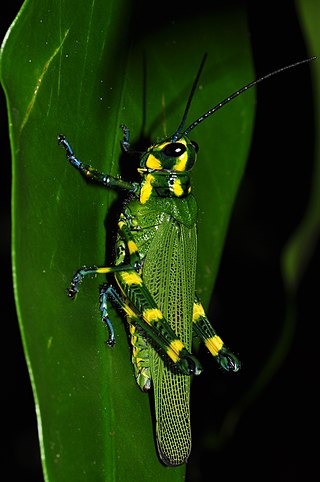
Chromacris is a genus of lubber grasshoppers in the family Romaleidae. The nine described species in Chromacris are found in Mexico, Central America, or South America. They often have bright aposematic colors and they are presumed to be toxic.

Timema knulli, Knull's Timema, is a stick insect native to California.

Dictyophorus is the type genus of grasshoppers in the tribe Dictyophorini, of the family Pyrgomorphidae; it is native to sub-Saharan Africa. The genus was named by Carl Peter Thunberg in 1815. They are relatively large, typically about 4–7 cm (1.6–2.8 in) long, and often have bright colurs warning of their toxicity.

Erechthis is a genus of Caribbean katydids in the tribe Agraeciini. They are distributed across a few islands in the Greater Antilles region.
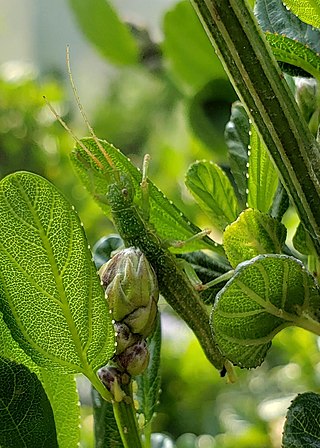
Timema monikense is a parthenogenetic stick insect native to California.
References
- ↑ Roth, Louis M.; Naskrecki, Piotr (2004). "A new genus and species of cave cockroach (Blaberidae: Oxyhaloinae) from Guinea, West Africa". Journal of Orthoptera Research . 13 (1): 57–61. doi:10.1665/1082-6467(2004)013[0057:ANGASO]2.0.CO;2. ISSN 1082-6467.